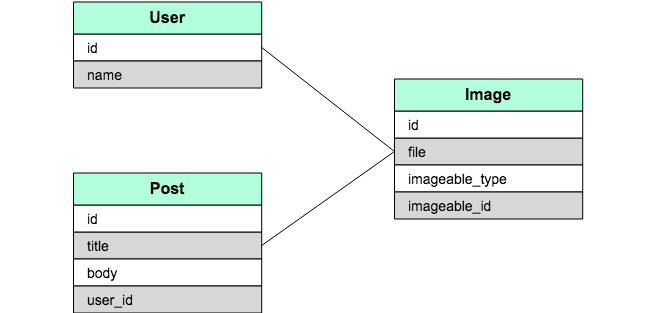3.3 アソシエーション
1対1の関連を定義する
モデルで「1対1」の関係を定義するにはhas_one、belongs_toを定義します。
例えば「Userが一つのPostを持っている」という状態を定義するには、
Userにhas_one、そしてPostにbelongs_toを定義し、外部キーuser_idをPostに追加する必要があります。
図で表すと以下のようになります。

class User < ApplicationRecord
has_one :post
end
class Post < ApplicationRecord
belongs_to :user
end
上記のように定義することで、UserからPostを参照、またPostにもbelongs_toが定義されているので、Userを参照することが可能になります。
1対多の関連を定義する
モデルで「1対多」の関係を定義するにはhas_many、belongs_toを定義します。
例えば「Userが複数のPostを持っている」という状態を定義するには、
Userにhas_many、そしてPostにbelongs_toを定義し、外部キーuser_idをPostに追加する必要があります。
図で表すと以下のようになります。

class User < ApplicationRecord
has_many :posts # 複数形になる
end
class Post < ApplicationRecord
belongs_to :user
end
上記のように定義することで、Userから複数のPostを参照、またPostにもbelongs_toが定義されているので、Userを参照することが可能になります。
多対多の関連を定義する
モデルで「多対多」の関係を定義するには複数関連させるための中間モデルを定義します。
例えば「Categoryが複数のPostを持っている、またPostは複数のCategoryの属している」という状態を定義するには、中間モデルCategoryPostが必要になります。
図で表すと以下のようになります。

CategoryPostはCategory、Postそれぞれに属しており、Category、Postはそれぞれ中間モデルを通して、もう一方のモデルを参照することになります。
class Category < ApplicationRecord
has_many :category_posts
has_many :posts, through: :category_posts
end
class CategoryPost < ApplicationRecord
belongs_to :category
belongs_to :post
end
class Post < ApplicationRecord
has_many :category_posts
has_many :categories, through: :category_posts
end
そして、CategoryおよびPostはそれぞれhas_manyで中間モデルを、またhas_many参照先のモデルをthroughオプションをつけて定義します。
ポリモーフィックな関連を定義する
ポリモーフィック関連は、1つのモデルが他の複数のモデルに属していることを表現することができます。
例えばImageモデルがあり、このモデルをUserモデルとPostモデルの両方に関連させることができます。
図で表すと以下のようになります。

ポリモーフィックモデルを定義するときは、参照先のidと参照先のモデル名を格納する2つのカラムが必要になります。
class User < ApplicationRecord
has_many :images, as: :imageable
end
class Post < ApplicationRecord
has_many :images, as: :imageable
end
class Image < ApplicationRecord
belongs_to :imageable, polymorphic: true
end
これによりUserおよびPostモデルからは複数のImageを参照できるようになります。
1対1のモデルの操作
1対1関連のモデルを定義します。
class User < ApplicationRecord
has_one :post
end
class Post < ApplicationRecord
belongs_to :user
end
このとき以下のメソッドが利用できます。associationは関連モデルになる。例)user.post
| メソッド | |
|---|---|
| association | 自分を参照しているオブジェクトを取得 |
| association=(associate) | associateを参照元として設定する |
| build_association(attributes = {}) | 新しいオブジェクトを作成 |
| create_association(attributes = {}) | 新しいオブジェクトを作成して保存 |
| create_association!(attributes = {}) | 新しいオブジェクトを作成して保存、失敗時に例外が発生 |
関連のモデルを作成する
$ post = user.create_post(title: 'これはタイトルです', body: 'これは本文です。')
=> #<Post id: 4, title: "これはタイトルです", body: "これは本文です。", created_at: "2018-06-26 16:05:42", updated_at: "2018-06-26 16:05:42", published_at: nil, user_id: 1>
関連のモデルを取得する
$ post.user
=> #<User id: 1, email: nil, password: nil, created_at: "2018-06-26 15:52:29", updated_at: "2018-06-26 15:52:29">
関連のモデルを更新する
$ user.post.update(title: 'タイトルを更新しました!')
=> true
$ user.post
=> #<Post id: 4, title: "タイトルを更新しました!", body: "これは本文です。", created_at: "2018-06-26 16:05:42", updated_at: "2018-06-27 08:22:55", published_at: nil, user_id: 1>
関連のモデルを削除する
$ user.post.destroy
=> #<Post id: 4, title: "タイトルを更新しました!", body: "これは本文です。", created_at: "2018-06-26 16:05:42", updated_at: "2018-06-27 08:22:55", published_at: nil, user_id: 1>
$ user.post
=> nil
1対多のモデルの操作
1対多関連のモデルを定義します。
class User < ApplicationRecord
has_many :posts
end
class Post < ApplicationRecord
belongs_to :user
end
このとき以下のメソッドが利用できます。collectionは関連モデルになる。例)user.posts
| メソッド | |
|---|---|
| collection | 関連づけされているモデルのコレクションを取得 |
| collection<<(object, …) | collectionにobjectを追加 |
| collection.delete(object, …) | objectを削除 |
| collection.destroy(object, …) | objectおよびその関連を削除 |
| collection.build(attributes = {}, …) | 新しいオブジェクトを作成 |
| collection.create(attributes = {}) | 新しいオブジェクトを作成して保存 |
関連のモデルを作成する
$ post = user.posts.create(title: 'これはタイトルです', body: 'これは本文です。')
=> #<Post id: 5, title: "これはタイトルです", body: "これは本文です。", created_at: "2018-06-27 08:36:22", updated_at: "2018-06-27 08:36:22", published_at: nil, user_id: 1>
関連のモデルを取得する
$ user.posts
=> #<ActiveRecord::Associations::CollectionProxy [#<Post id: 5, title: "これはタイトルです", body: "これは本文です。", created_at: "2018-06-27 08:36:22", updated_at: "2018-06-27 08:36:22", published_at: nil, user_id: 1>]>
関連のモデルをすべて削除する
$ user.posts.destroy_all
=> #[<Post id: 5, title: "これはタイトルです", body: "これは本文です。", created_at: "2018-06-27 08:37:45", updated_at: "2018-06-27 08:37:45", published_at: nil, user_id: 1>]
$ user.posts
=> #<ActiveRecord::Associations::CollectionProxy []>
多対多のモデルの操作
多対多関連のモデルを定義します。
class Category < ApplicationRecord
has_many :category_posts
has_many :posts, through: :category_posts
end
class CategoryPost < ApplicationRecord
belongs_to :category
belongs_to :post
end
class Post < ApplicationRecord
has_many :category_posts
has_many :categories, through: :category_posts
end
このとき以下のメソッドが利用できます。collectionは関連モデルになる。例)category.posts
| メソッド | |
|---|---|
| collection | 関連づけされているモデルのコレクションを取得 |
| collection<<(object, …) | collectionにobjectを追加 |
| collection.delete(object, …) | objectを削除 |
| collection.destroy(object, …) | objectおよびその関連を削除 |
| collection.build(attributes = {}, …) | 新しいオブジェクトを作成 |
| collection.create(attributes = {}) | 新しいオブジェクトを作成して保存 |
関連のモデルを作成する
$ post = category.posts.create(title: "カテゴリの投稿")
=> #<Post id: 5, title: "カテゴリの投稿", body: nil, created_at: "2018-06-27 08:53:18", updated_at: "2018-06-27 08:53:18", published_at: nil, user_id: nil>
関連のモデルを取得する
$ category.posts
=> #<ActiveRecord::Associations::CollectionProxy [#<Post id: 5, title: "カテゴリの投稿", body: nil, created_at: "2018-06-27 08:53:18", updated_at: "2018-06-27 08:53:18", published_at: nil, user_id: nil>]>
関連のモデルをすべて削除する
$ category.posts.destroy_all
=> [#<Post id: 5, title: "カテゴリの投稿", body: nil, created_at: "2018-06-27 08:53:18", updated_at: "2018-06-27 08:53:18", published_at: nil, user_id: nil>]
$ category.posts
=> #<ActiveRecord::Associations::CollectionProxy []>